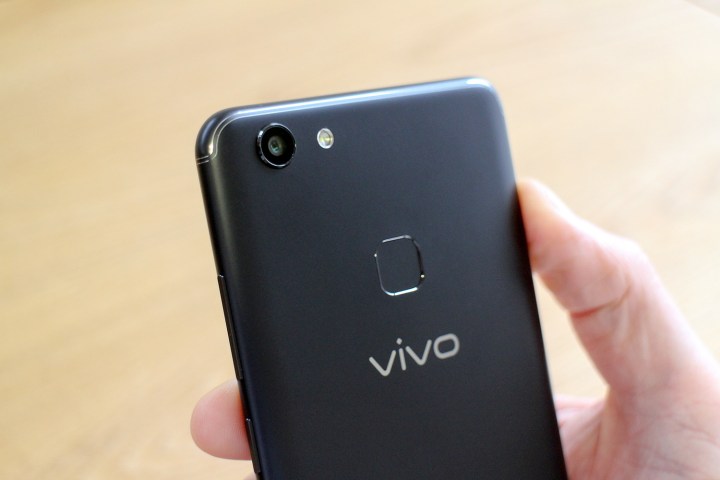Vivo, a Chinese smartphone manufacturer, is attracting a lot of attention at the moment due to its work on an under-glass fingerprint sensor. This technology, which hasn’t been perfected by Apple or Samsung yet, will debut on a Vivo phone in the near future. It won’t be the first time Vivo has been a phone trendsetter; but it’s likely the first time you’re hearing about its devices — you won’t find Vivo phones sold in the U.S. or the U.K.
This is an incredible selfie phone.
But through small steps, Vivo’s international reach is increasing, especially with the launch of the Vivo V7 Plus. Starting out in China and followed by India, the phone is now destined to launch in Russia, Singapore, Taiwan, and several other regions. It’s evidence of Vivo stretching out further into the world. In our Vivo V7 Plus review, we find out if the company is ready for prime time outside China.
A focus on selfies
The reason you’ll want to buy the Vivo V7 Plus is the camera, and not just the rear camera either: This is an incredible selfie phone. The front camera has 24 megapixels and an f/2.0 aperture, along with a Portrait mode, HDR, and a comprehensive beauty mode. Those are better specifications than many other rear cameras, but does it make a difference? It really does, and the selfies you take with the V7 Plus are impressive. With beauty mode active, you have the option of adjusting three parameters — skin buffing, whitening, and skin tone — and provided you don’t just turn them all up to maximum, it’s easy to retain a normal, human look. Just without those tiny little flaws we’d rather hide.
Portrait mode depends on software to blur out the background, rather than a second lens, and it does a good job in normal lighting. It avoids blurring out glasses, but while it can get a little confused with ears, it otherwise effectively isolates your face. The HDR mode isn’t so great, and we often struggled to see the difference when it was turned on. There’s a front-facing flash, a wide array of filters, and a group selfie mode too. Simply put — if you want to take selfies, the V7 Plus is an absolute master.
Both cameras impress
The rear camera hasn’t been forgotten either. It has a single-lens 16-megapixel camera with the same f/2.0 aperture, as well as the beauty mode from the selfie camera too. It’s well-tuned, fast to react, and easy to use. Put up against two other similarly-priced phones, the Vivo V7 Plus took our favorite shot of the afternoon — a clock tower highlighted against clouds and the setting sun, complete with birds flying away to roost. The Vivo V7 Plus took photos we liked with both the front and the rear camera.
It’s not without fault though. Oddly there’s no grid option under the settings, and it has one of those pointless Apple Live Photo rip-offs that we struggle to find a use for. This leads us from the Vivo V7 Plus’ major selling point, to its worst aspect — the software. It runs Android 7.1.2 with November 2017’s security patch, which is an unfortunate, but acceptable start. The current version of Android is version 8.0 with the January security patch. But what bothers us more is how the operating system is covered with Vivo’s own FunTouchOS “theme” or user interface. FunTouch is not much fun at all.
FunTouch is not much fun at all.
We’re not fans of FunTouchOS mainly because it makes you relearn everything you know from other Android phones. Looking for the brightness control? It’s in the notification shade, right? No, it’s actually in a pull up drawer from the bottom of the screen, along with all the other shortcuts. There’s no app drawer, the notifications are massive cards that drop down into view, the network connectivity icon is on the opposite side, and there are various pre-installed apps. It’s not slow, and we didn’t experience any app incompatibility — so it’s not that it doesn’t work — it just wants to be different for no apparent reason. We do like the customizable themes though, accessed through a pre-installed themes app, and Google Play along with all the Google apps are also ready to go. Still, we couldn’t put down the desire to change the launcher on the Vivo V7 Plus.
Software experience lets it down
The Vivo V7 Plus looks good, especially in the black seen here. It’s understated, the antenna bands are split into subtle tram lines around the top and bottom of the device, and the fingerprint sensor is well-placed on the back of the phone. The 6-inch screen has minimal bezels for a really modern look, but we’re disappointed with the 720 x 1,440 pixel resolution. It’s too low, and ruins what could have been a pleasant experience watching high definition video on a large screen. Other quibbles include a MicroUSB charging port rather than a USB Type-C; but at least there is a 3.5mm headphone port.
The phone is powered by a Snapdragon 625 processor with 4GB of RAM, and we ran some benchmark tests to see how it compares to the competition.
- AnTuTu 3D: 56,226
- Geekbench 4: Single-Core: 764; Multi-Core: 3,925
- 3DMark Sling Shot Extreme: 430
The Vivo V7 Plus costs around $350. Do note, if you decide to import one to the U.S., it won’t connect to a 4G LTE service, only 3G, and it’s a GSM phone for use with AT&T or T-Mobile. The price puts it in competition with the Motorola X4, the HTC U11 Life, and beyond the Honor 7X. Its benchmark results are less impressive than the Moto and the HTC phones, and very similar to the Honor 7X. We played Riptide GP2 and found the V7 Plus works well as a gaming device. There’s even a handy little shortcut in the pull-up menu to activate a game mode to silence notifications.
Price is too high
We’re a little confused by the Vivo V7 Plus. The cameras are superb, the screen — although modern looking — isn’t so good, the price is a little too high, and the user interface is quite frustrating. It comes close, but we can’t recommend this phone. If you can live with the operating system, the selfie experience truly stands apart from other phones at this price.












